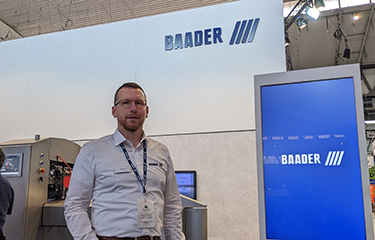Seafood companies around the globe have faced a drastic shortage of workers as a result of the COVID-19 pandemic and its ripple-effects.
Even though many countries are beginning to ease off their more-stringent COVID-19-pandemic-related restrictions, the seafood industry is reported a continued struggle with a scarcity of labor.
“We have gotten through COVID to the greatest extent, and I think a lot of processers and the seafood industry has been expecting that there’s a lot more labor coming back,” Baader North America CEO Nils Rabe told SeafoodSource. “We are still lacking labor, and the prices for labor, especially for the seafood industry, increased a lot.”
Speaking with SeafoodSource at Seafood Expo Global in Barcelona, Spain, on 28 April, Rabe said Baader seafood companies around the world are responding to the labor crunch by automating more of their processing.
“We see a great demand for automation, for process improvement in general,” Rabe said.
Even prior to the COVID-19 pandemic, seafood-processing companies were becoming more interested in automation, according to Rabe. But in the past two years, the shift has accelerated, he said.
“In the past, it was more like, ‘Hey, I want to fillet a fish. What’s the machine for that?’” Rabe said. “Now that’s different, that’s changed.”
Instead of companies seeking out a particular piece of equipment that can perform a single role, many are seeking a complete transformation of their entire processing lines, Rabe said.
“In the past, we have been more involved in individual product supplies – so in equipment, in a machine,” Rabe said. “Now, we are more involved in a complete processing solution, consisting of several machines or one machine with the add-ons and combinations.”
Baader itself moved to an emphasis on complete solutions prior to COVID, Rabe said, leaving the company in a good position to accommodate companies making the transition.
“We started jumping onto that train a long time ago,” Rabe said. “With our wall-to-wall solutions in the salmon industry, we are well-settled in several markets.”
Baader has bulked up its offerings through both internal product development and via acquisitions. It purchased Skaginn 3X in October 2020 and acquired SEAC AB in January 2021. Baader's main rival, Marel, has kept pace through the purchase of Valka in July 2021, at the time expressing a primary goal of the move as being the strengthening its full-line offerings.
Rabe said Baader's new acquisitions have allowed it to offer a greater selection of processing solutions for a wider variety of seafood species.
“We now have the opportunity to offer wall-to-wall solutions and full-processing solutions, not only in salmon, but in whitefish, in pelagic, in tuna processing, in redfish processing, in crab processing,” Rabe said. "We really feel we are well set up for the coming years."
Rabe said the North American market represents a primary opportunity for Baader to expand its sales of full-processing solutions. Supply-chain difficulties are leading U.S. companies to consider reshoring some seafood processing activity, which for the U.S. market is primarily completed in China. But the growing complexity of sourcing seafood from China is creating an opportunity for U.S. processors, Portland, Maine, U.S.A.-based Peter Handy told SeafoodSource in December 2021.
Reis Consulting Principal Judson Reis told SeafoodSource in March 2022 U.S. processors will only be successful by maximizing efficiency while minimizing labor costs.
“It’s very unclear at this point, particularly with wages rising as quickly as they are in the U.S., that the [cost] gap is going to improve from where it is right now. In fact, it may widen – it really depends on product,” Reis said. “If a product has a very high labor requirement, it’s still going to be cheaper to process it in other parts of the world rather than the U.S. The drive for efficiency will trump other considerations. At the end of the day, if you end up with uncompetitively-priced products, they’re not going to be as well-received in the marketplace.”
The biggest hurdle, Reis said, is the cost of labor. Rapid advances in automation could cut down on that cost, he said.
“If you can replace some of that labor with machines and robotics, you can use it to improve your operations year-in and year-out,” Reis said.
Photo by Chris Chase/SeafoodSource







